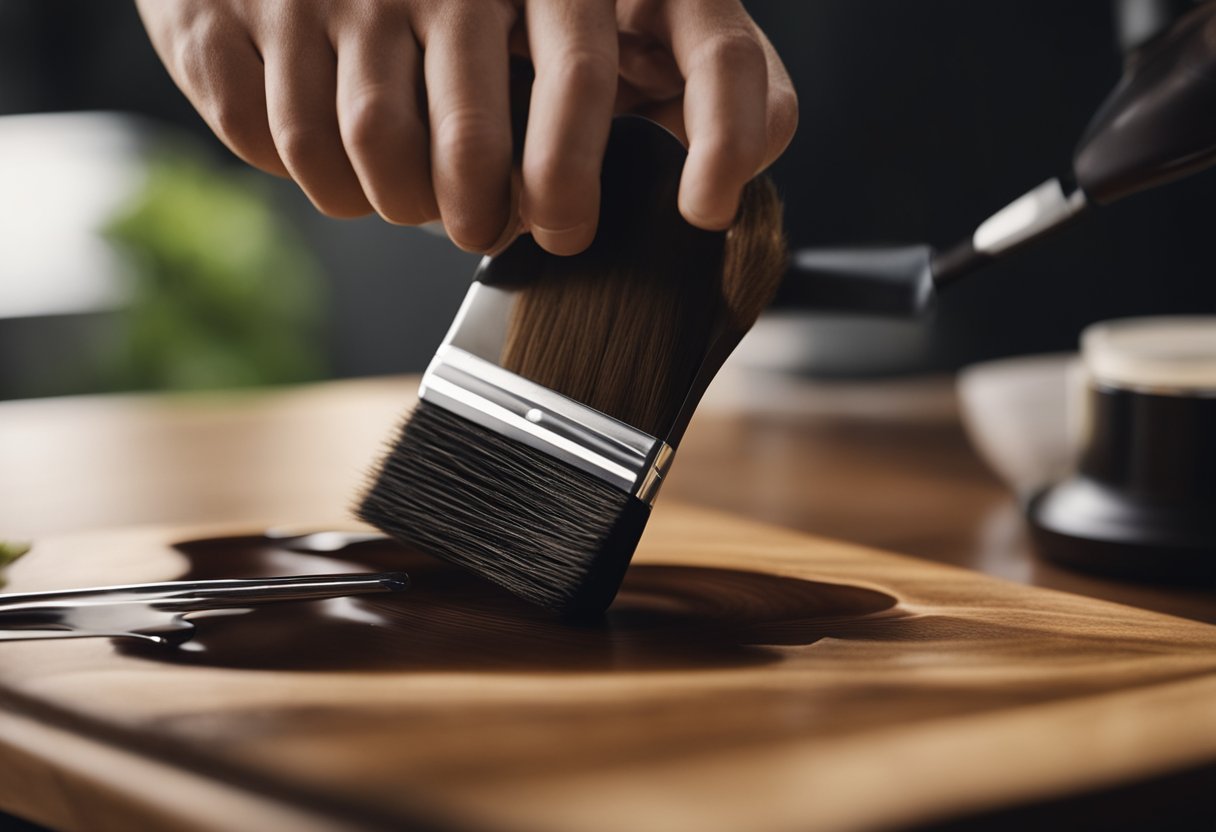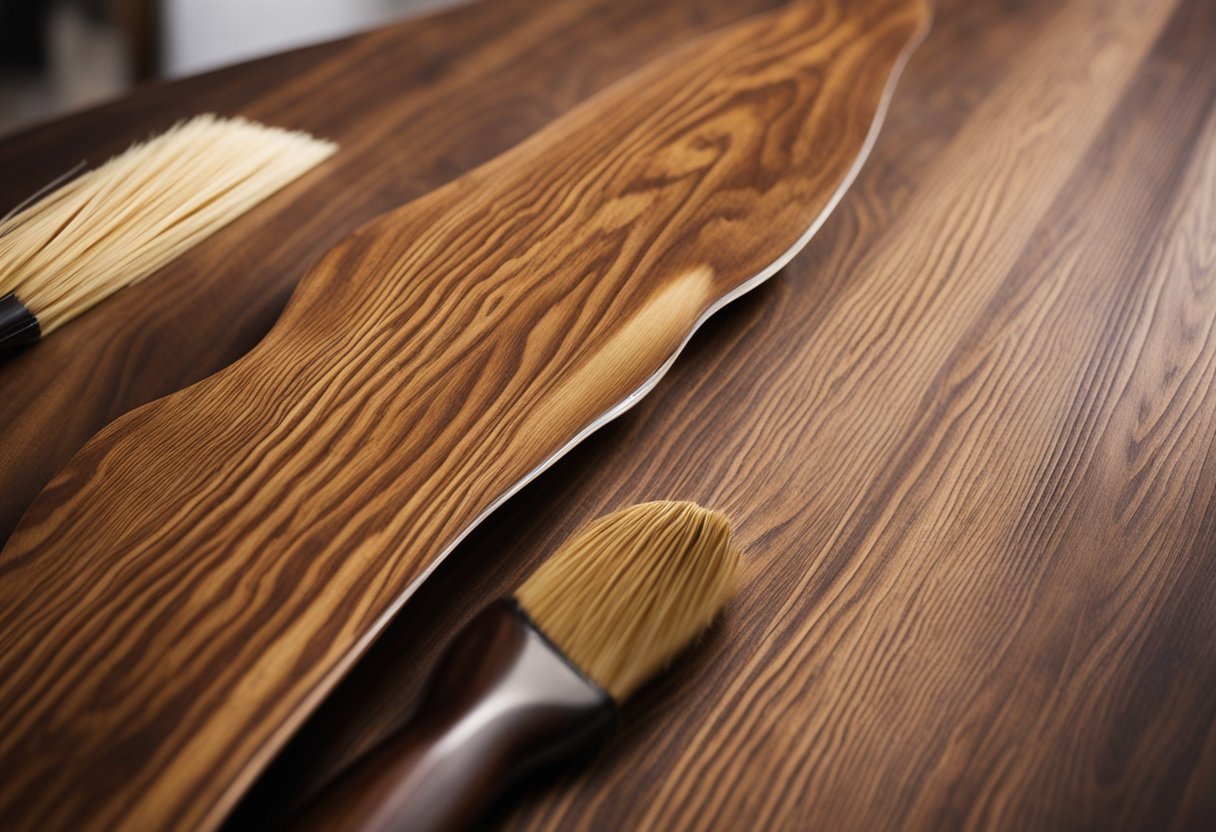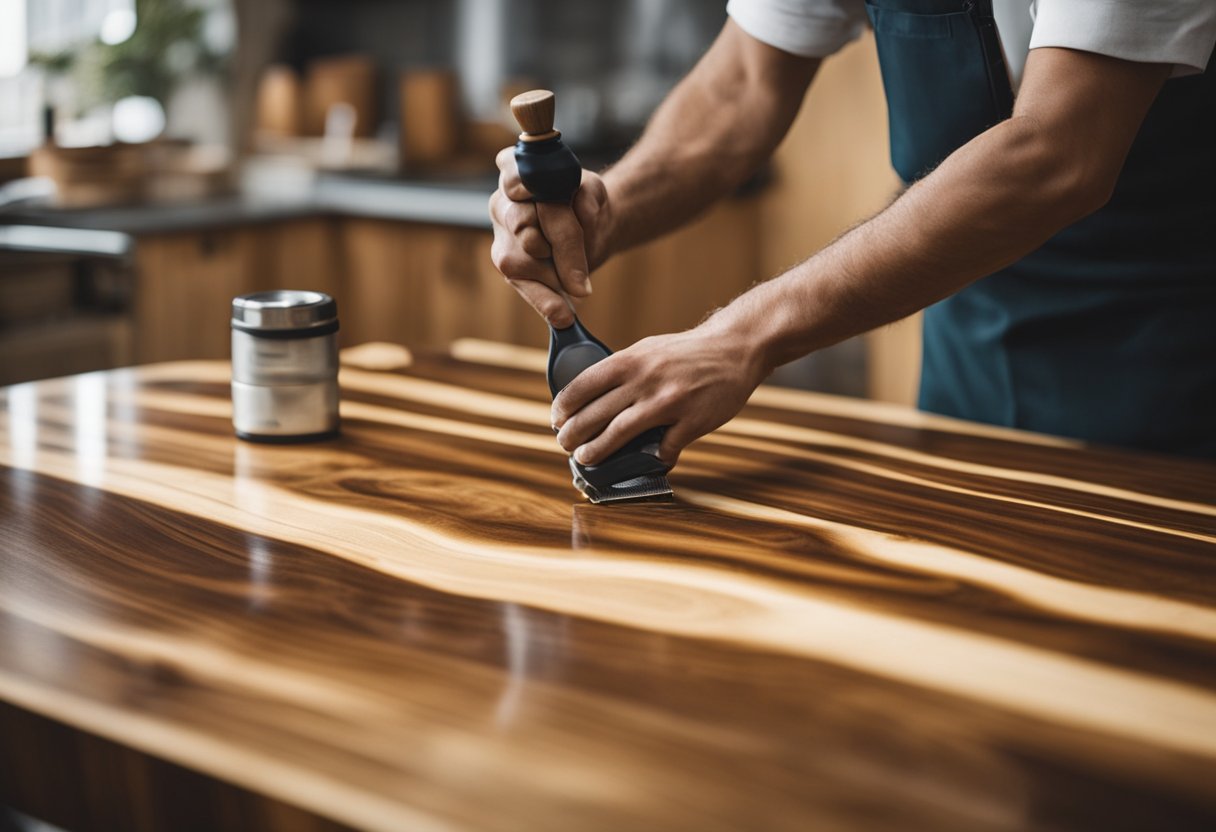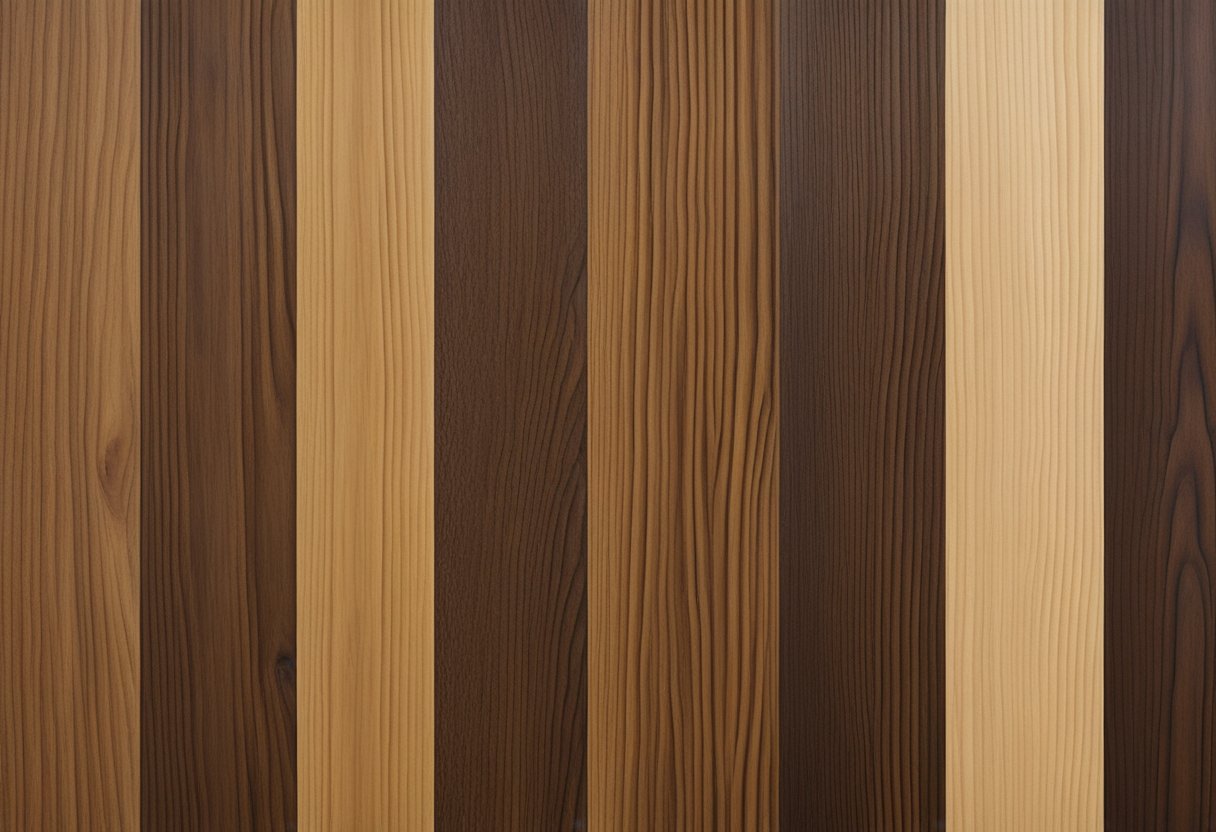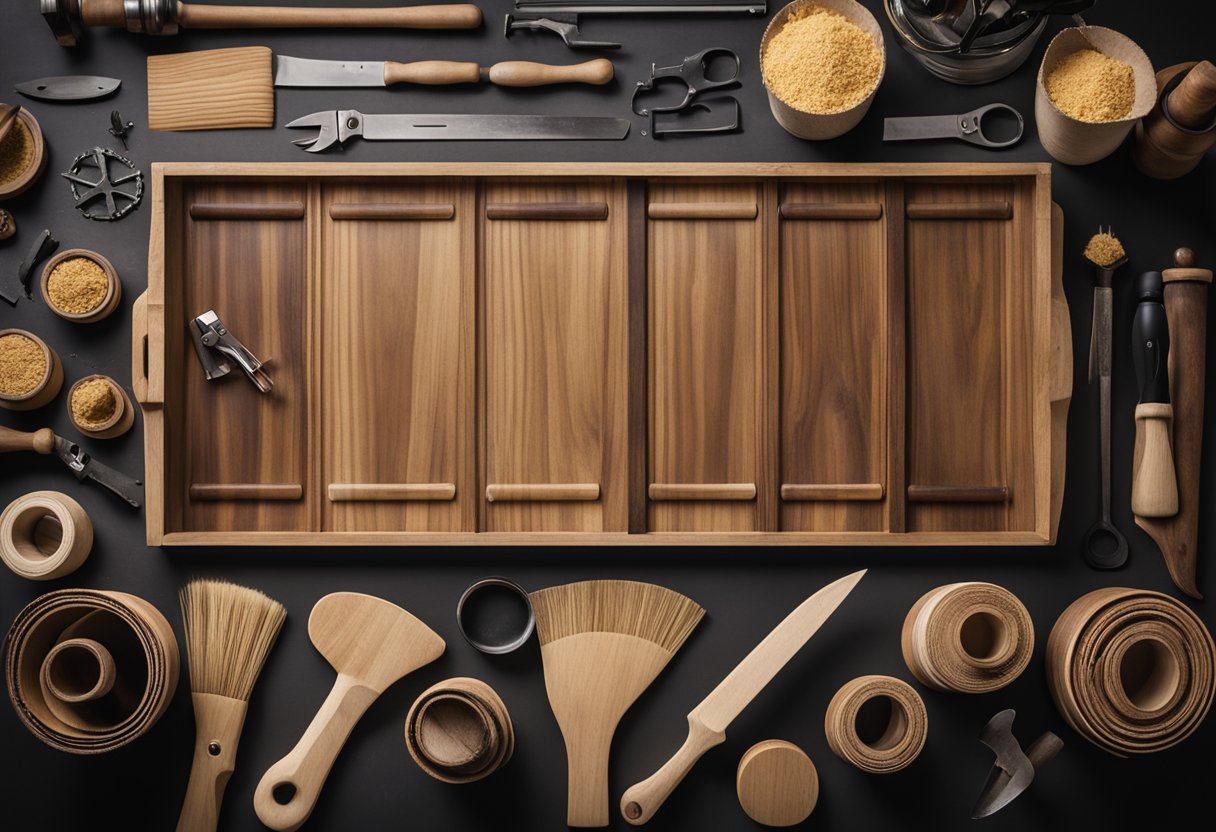Staining poplar to look like walnut is a popular technique among woodworkers because it allows them to achieve the luxurious look of walnut without the high cost. Poplar is a budget-friendly wood that is easy to work with, but it lacks the natural beauty and warmth of walnut. By applying the right stain and technique, however, poplar can be transformed into a stunning walnut lookalike.
Understanding poplar wood is crucial to achieving a walnut finish. Poplar is a softwood with a closed-pore structure that makes it challenging to stain. Unlike hardwoods such as walnut, poplar does not have a distinctive grain pattern that adds character to the wood. It is also prone to blotchiness and uneven absorption of stain, which can result in an unattractive finish. However, with the right preparation and techniques, poplar can be stained to look like walnut.
Key Takeaways
- Poplar wood is a budget-friendly and easy-to-work-with option for woodworking projects.
- Achieving a walnut look on poplar requires the right preparation, technique, and type of stain.
- With patience and practice, poplar can be transformed into a stunning walnut lookalike.
Understanding Poplar Wood
https://www.youtube.com/watch?v=r5VbYl8w8cA&embed=true
As a woodworker, I know that poplar is an affordable and sustainable hardwood that is widely available in lumberyards. Poplar wood is light in color, and it is not the most appealing for some projects. However, it is a versatile wood that can be stained to resemble more expensive hardwoods like walnut.
Poplar is classified as a hardwood, but it is not as hard as other hardwoods like oak or maple. Its Janka hardness rating is 540, which is much lower than oak’s 1360 or maple’s 1450. However, it is still harder than some softwoods like pine or cedar. Poplar is also known for its closed pore structure, which means it has a smooth surface that is easy to sand and finish.
In its natural state, poplar wood has a light cream or yellowish color, with occasional streaks of green, gray, or purple. These streaks are caused by mineral deposits in the wood, and they can create interesting patterns when the wood is finished. However, if you want a darker and richer color, you can stain poplar to resemble walnut.
Staining poplar to look like walnut can be a challenging process, as poplar has a reputation for being difficult to stain. Its closed pore structure means that it can absorb stain unevenly, resulting in a blotchy appearance. However, with the right techniques and products, you can achieve a beautiful walnut-like finish on poplar wood.
Preparation for Staining
https://www.youtube.com/watch?v=jrHy7AgMmzo&embed=true
Before staining poplar to look like walnut, it is important to properly prepare the wood to ensure a smooth and even finish. Here are the steps I take to prepare the poplar:
Sanding
The first step in preparing poplar for staining is to sand it thoroughly. Sanding removes any rough spots or blemishes on the surface of the wood, creating a smooth and even surface for the stain to be applied. I typically start with a coarse sandpaper, such as 80 grit, and work my way up to a finer grit, such as 220 grit, to achieve a smooth finish.
Wood Conditioner
After sanding, it is important to apply a wood conditioner to the poplar. A wood conditioner helps to even out the absorption of the stain, preventing blotchiness and ensuring a consistent color. I recommend using a pre-stain wood conditioner, which is specifically designed to be used before staining.
Work Area
It is important to work in a well-ventilated area when staining poplar. I recommend setting up a workspace outside or in a well-ventilated area of your home. Additionally, it is important to wear a respirator to protect yourself from any fumes that may be released during the staining process.
By following these steps, you can ensure that your poplar is properly prepared for staining and will result in a beautiful finish that resembles walnut wood.
Types of Stains
https://www.youtube.com/watch?v=iZE88nqFpww&embed=true
When it comes to staining poplar to look like walnut, there are a few types of stains to consider. The two main categories of stains are oil-based and water-based. Gel stains are also an option, but they are typically oil-based.
Oil-based stains are popular because they penetrate the wood deeply, providing a rich, even color. They also tend to be more durable than water-based stains. However, oil-based stains take longer to dry and can emit strong fumes, so proper ventilation is crucial.
Water-based stains are a more eco-friendly option, as they contain fewer harmful chemicals and dry more quickly. They are also easier to clean up with soap and water. However, they do not penetrate the wood as deeply as oil-based stains, so the color may not be as rich or long-lasting.
Gel stains are thicker than regular oil-based stains and can be easier to apply without drips or splatters. They are especially useful for vertical surfaces or intricate details. Minwax Gel Stain and Walrus Oil are popular options for staining poplar to look like walnut.
When it comes to color, dark stains are the obvious choice for mimicking the look of walnut. Red gel stains, such as Minwax Red Mahogany, can also be used to achieve a similar effect. For an even darker look, try Minwax True Black. Dyes are another option for achieving a specific color, but they require more skill and experience to use effectively.
Overall, the type of stain you choose will depend on your personal preference and the specific project you are working on. Consider the pros and cons of each type of stain, as well as the color options available, to make the best choice for your needs.
Staining Process
https://www.youtube.com/watch?v=VXOUE5_Mjmg&embed=true
Staining poplar to look like walnut can be a challenging task, but with the right tools and techniques, it is possible to achieve a beautiful finish. Here is my step-by-step process for staining poplar to look like walnut:
-
Sand the poplar wood to a smooth finish, starting with a coarse sandpaper and gradually moving to a finer grit. This will help the wood absorb the stain evenly.
-
Apply a coat of pre-stain conditioner to the poplar wood using a clean applicator or brush. This will help prevent blotchy appearance and ensure an even stain.
-
Apply the first coat of stain to the poplar wood using a lint-free rag or brush. Be sure to work in the direction of the grain and wipe off any excess stain with a clean rag.
-
Allow the first coat of stain to dry for the recommended drying time, usually 24 hours.
-
Apply a second coat of stain to the poplar wood, following the same process as the first coat. This will help deepen the color and achieve an even stain.
-
Allow the second coat of stain to dry for the recommended drying time, usually 24 hours.
-
If desired, apply a clear coat of polyurethane to the poplar wood to protect the finish and add shine.
By following these steps, you can achieve a beautiful finish on poplar wood that looks like walnut. Remember to take your time and work carefully to ensure an even stain.
Achieving the Walnut Look
https://www.youtube.com/watch?v=0EjIjCvxVGI&embed=true
When it comes to staining poplar to look like walnut, the most important thing to consider is the color. Walnut has a rich, deep brown color that can be achieved by using a dark walnut stain. 1
To bring out the grain pattern in poplar, it is important to use a high-quality stain that will penetrate the wood evenly. One such product is Varathane Premium Fast Dry Wood Stain. 2 This stain is specially formulated to absorb stains evenly and deeply into the wood, resulting in a rich, even color.
Another way to achieve the walnut look is to use a weathered wood accelerator. This product is designed to simulate the natural aging process of wood, resulting in a weathered, rustic look that is similar to walnut. 3
It is important to note that poplar has a fairly even grain, which can make it difficult to achieve the same depth and variation of color as walnut. However, by using a dark brown stain and applying it evenly, it is possible to achieve a similar look. 4
In addition to using the right stain, it is also important to prepare the wood properly before staining. This includes sanding the wood to remove any rough spots or imperfections, and ensuring that the surface is clean and free of dust. By taking the time to properly prepare the wood, you can ensure that the stain will be absorbed evenly and result in a beautiful, walnut-like finish.
Finishing Touches
Now that the poplar board has been stained to look like walnut, it’s time to add the finishing touches to achieve a professional look. As a woodworker, I know that the final step of any project is crucial in determining the overall quality of the work. Here are some tips to ensure that your poplar board looks like a walnut masterpiece:
Applying a Topcoat
After staining, it’s important to apply a topcoat to protect the wood and give it a polished finish. A topcoat can be either varnish or shellac, depending on your preference. Varnish is more durable and provides better protection, while shellac is easier to apply and dries faster.
To apply the topcoat, use a brush or a spray gun. Make sure to apply a thin, even coat and let it dry completely before applying the next coat. Sand lightly between coats to remove any imperfections and ensure a smooth finish.
Choosing the Right Topcoat
When choosing a topcoat, consider the type of project you’re working on. For furniture and cabinets, a clear, high-gloss varnish is ideal. For woodworking and boards, a satin or matte varnish will provide a more natural look.
Highlighting the Wood Grain
To highlight the wood grain and give it a more natural look, use a glaze or a toner. A glaze is a transparent layer that is applied over the stain to add depth and richness to the color. A toner is a colored layer that is applied over the glaze to adjust the color and highlight the wood grain.
To apply the glaze or toner, use a brush or a spray gun. Make sure to apply a thin, even coat and let it dry completely before applying the next coat. Sand lightly between coats to remove any imperfections and ensure a smooth finish.
By following these tips, you can achieve a professional look when staining poplar to look like walnut. Whether you’re working on furniture, cabinets, woodworking, or boards, the right topcoat and finishing touches can make all the difference.
Troubleshooting Common Issues
Staining poplar to look like walnut can be a challenging task, and it’s not uncommon to encounter some issues along the way. In this section, I will provide some troubleshooting tips to help you overcome some common problems.
Blotches
One of the most common issues when staining poplar is blotching. Poplar has a tendency to absorb stain unevenly, resulting in a blotchy appearance. To prevent this, I recommend using a pre-stain wood conditioner. This will help seal the wood and create a more even surface for the stain to adhere to.
Streaks and Blotches
Another issue that can arise when staining poplar is streaking and blotching. This can occur when using a low-quality brush or when applying too much stain at once. To avoid this, I recommend using a high-quality brush and applying the stain in thin, even coats. Be sure to wipe off any excess stain with a clean rag to prevent streaking.
Grains
Poplar wood has a unique grain pattern that can make it difficult to achieve a uniform stain color. To minimize the impact of the grain, I recommend using a gel stain. Gel stains are thicker than traditional stains and can help fill in the grain, resulting in a more even finish.
DIY
If you’re new to staining wood, it’s important to remember that this is a DIY project that requires patience and practice. Don’t be discouraged if your first attempt doesn’t turn out perfectly. With practice, you’ll be able to achieve the perfect stain color.
Wood Stains
Choosing the right wood stain is crucial when staining poplar to look like walnut. I recommend using an oil-based stain, as it penetrates the wood more deeply and provides a longer working time. Water-based stains can also be used, but they tend to dry more quickly and can result in a less even finish.
Mineral Spirits
Mineral spirits are a useful tool for cleaning up after staining poplar. They can help remove excess stain and clean up any spills or drips. Be sure to wear gloves and work in a well-ventilated area when using mineral spirits.
Tack Cloth
After sanding the wood, it’s important to remove any dust or debris before applying the stain. A tack cloth is a great tool for this. It’s a sticky cloth that picks up dust and debris without leaving any residue behind.
Dish Soap
Before staining poplar, it’s important to clean the wood thoroughly. I recommend using a mixture of dish soap and water to remove any dirt or grime. Be sure to rinse the wood thoroughly and allow it to dry completely before applying the stain.
By following these troubleshooting tips, you’ll be able to overcome common issues when staining poplar to look like walnut. Remember to take your time, practice, and be patient, and you’ll be able to achieve the perfect finish.
Alternative Woods for Walnut Staining
If you’re looking to achieve the look of walnut but don’t have access to it, there are several alternative woods that can be stained to look like walnut. Here are some of the most popular options:
Cherry
Cherry wood has a similar grain pattern to walnut, making it an excellent choice for staining to achieve the look of walnut. Cherry wood is also a hardwood, which means it is strong and durable, just like walnut. However, cherry wood is typically more expensive than other woods, so it may not be the best choice if you’re on a tight budget.
Maple
Maple is another hardwood that can be stained to look like walnut. Like oak, it is strong and durable. Maple also has a close grain pattern to walnut, making it a good choice for those looking to achieve a similar look. However, maple wood is typically lighter in color than walnut, so you’ll need to use a darker stain to achieve the desired effect.
Oak Wood
Oak wood is another alternative for staining to look like walnut. Oak has a similar grain pattern to walnut, but it is typically lighter in color. Like cherry and maple, oak is also a hardwood, making it strong and durable. However, oak can be more difficult to stain evenly than other woods, so it may require more skill and patience to achieve the desired effect.
Plywood
Plywood is a budget-friendly option for staining to look like walnut. While it is not a solid wood, plywood can be made to look like walnut with the right stain and finishing techniques. However, it is important to note that plywood typically has a more uniform grain pattern than solid wood, so it may not look exactly like walnut. Additionally, plywood is not as strong or durable as solid wood, so it may not be the best choice for high-traffic areas or heavy use.
Overall, when choosing an alternative wood for walnut staining, it is important to consider factors such as budget, desired look, and durability. By carefully selecting the right wood and using the proper staining and finishing techniques, you can achieve a beautiful walnut-like finish on a variety of different woods.
Safety Considerations
When working with stains and finishes, it is important to take safety precautions to protect yourself and those around you. Here are some safety considerations to keep in mind when staining poplar to look like walnut:
Personal Protective Equipment
Wearing personal protective equipment (PPE) is essential when working with stains and finishes. This includes wearing gloves, eye protection, and a respirator. A respirator is particularly important when working with oil-based stains, as they can release harmful fumes. It is important to choose a respirator that is appropriate for the type of stain you are using and to follow the manufacturer’s instructions for use.
Work Area
When working with stains and finishes, it is important to have a well-ventilated work area. This can be achieved by opening windows and doors or using a fan to circulate air. It is also important to work in a clean, clutter-free area to avoid tripping hazards or accidental spills. Cover any nearby surfaces with plastic or drop cloths to protect them from accidental spills.
Handling and Disposal
When handling stains and finishes, it is important to follow the manufacturer’s instructions for use and disposal. Store stains and finishes in a cool, dry place and away from sources of ignition. Dispose of any unused or unwanted stains and finishes according to local regulations. Do not pour them down the drain or into the trash.
By following these safety considerations, you can ensure that your staining project is completed safely and successfully.
Frequently Asked Questions
What are the best stains to use on poplar wood?
There are several stains that work well on poplar wood, including oil-based stains, water-based stains, and gel stains. The best stain for poplar depends on the desired color and the project’s requirements. Some popular stain brands for poplar wood include Varathane, Minwax, and General Finishes.
How can I make poplar wood look like walnut?
To make poplar wood look like walnut, you can use a combination of wood stain and wood grain filler. Start by applying a coat of wood grain filler to the poplar wood and let it dry completely. Once dry, apply a coat of wood stain to the wood and let it dry completely. Repeat these steps until you achieve the desired color and grain pattern.
Does poplar wood take stain well?
Poplar wood is a relatively soft wood that can absorb stain unevenly, making it challenging to achieve an even finish. However, with proper preparation and technique, poplar wood can take stain well. It’s essential to sand the wood thoroughly, starting with a coarse grit sandpaper and finishing with a fine grit sandpaper. Applying a pre-stain wood conditioner can also help the wood absorb the stain more evenly.
What color stain looks best on poplar?
The best color stain for poplar depends on the desired look and project requirements. Poplar wood has a natural greenish hue, which can affect the final stain color. Some popular stain colors for poplar include dark walnut, cherry, and antique oak. It’s recommended to test the stain on a scrap piece of wood to ensure the desired color is achieved.
Can you stain poplar wood to look like oak?
While it’s possible to stain poplar wood to look like oak, it’s challenging to achieve an exact match due to the differences in the wood’s natural grain pattern. However, by using a combination of wood stain and wood grain filler, you can create a finish that resembles oak.
Is gel stain a good option for staining poplar?
Gel stain is an excellent option for staining poplar wood because it’s thick and easy to apply, making it less likely to drip or splatter. Additionally, gel stain can help even out the absorption of the stain, resulting in a more uniform finish. However, it’s essential to follow the manufacturer’s instructions carefully and test the stain on a scrap piece of wood before applying it to the project.
Footnotes

Hi, I’m Sal Muller of Tooltrip.com. My DIY experience led me to understand essential power tools for home projects. Tooltrip.com guides enthusiasts and professionals in choosing right tools for any job. I provide concise top tool reviews for easier, efficient DIY.

